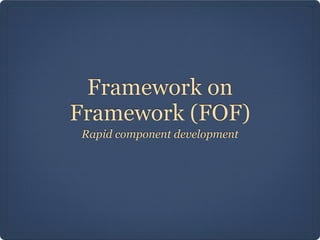FOF Rapid Application Development on Joomla! - Joomla! Day Denmark 2012
- 1. Framework on Framework (FOF) Rapid component development
- 2. What is FOF? Or, rather, what's it not?
- 3. Not a fork of another framework (or trying to sell you a fork of your favourite CMS...)
- 4. Not the best thing since sliced bread
- 5. Not A Real Framework (NARF)
- 6. FOF extends the Joomla! MVC API It does not replace or undermine it
- 7. FOF is licensed under GNU/GPL Note: itŌĆÖs GPL version 3 or later
- 8. Design goals ŌĆó DRY - Don't Repeat Yourself. Copying & pasting code is the source of all evil. ŌĆó Write less, do more - less code, less failure points ŌĆó It should never impose its own way of thinking. Gets out of your way when you want to work around it. ŌĆó Backwards compatibility - no surprising, quantum changes every few days ŌĆó Joomla! version abstraction (1.5, 2.5 and 3.0 supported)
- 9. Key features ŌĆó Convention over configuration, Rails style ŌĆó Use a query builder, even on Joomla! 1.5 ŌĆó HMVC today, not in 3 years, without relearning component development ŌĆó Easy reuse of view template files without ugly include() ŌĆó Automatic language loading and easy overrides ŌĆó Media files override (works like template overrides) ŌĆó Automatic JSON and CSV views with no extra code ŌĆó Automatic Joomla! version template overrides (e.g. default.j30.php)
- 10. Overview of a component ŌĆó The Dispatcher is the entry point. It will setup, run and render the MVC view ŌĆó The Controller is a thin interface to push data to the model state and instantiate views ŌĆó The Model is the workhorse. Business logic goes here. ŌĆó The Table class is a hybrid data adapter, controller and model (following J!'s convention) ŌĆó The View fetches model state data and renders them in a meaningful way ŌĆó The Toolbar handles the rendering of titles, buttons and so on
- 11. Convention over configuration in Models ŌĆó Tables are named as #__component_view, e.g. #__todo_items ŌĆó Auto increment field is named component_view_id, e.g. todo_item_id ŌĆó Magic fields: enabled, created_by, created_on, modified_by, modified_on, locked_by, locked_on, hits ŌĆó You can override defaults without copying & pasting code, ever. Copy & paste is the devil!
- 12. Convention over configuration in Controllers ŌĆó Default tasks (not RESTful!): browse, read, edit, add, delete, save, apply, ... ŌĆó Customize with onBeforeMethod and onAfterMethod methods, e.g. onBeforeSave. Don't copy & paste code. ŌĆó All MVC objects can be passed a $config array to customize them. It "flows" from dispatcher to component to model and view. ŌĆó FOF guesses the task if it's missing based on plural/ singular view name and existence of ID in the query
- 13. Convention over configuration in Views ŌĆó Views inherit from FOFView and its specialized children, e.g. FOFViewHtml ŌĆó Customize using the onTask methods, e.g. onBrowse ŌĆó The toolbar is handled outside the view, in a FOFToolbar descendant class. Override it with a toolbar.php file in the component's root. ŌĆó Magic toolbar methods, e.g. onItemsBrowse allow you to customize the toolbar without copying & pasting code.
- 14. HMVC ŌĆó Include the results of component views anywhere (other views, other component, modules, ...) ŌĆó FOFDispatcher::getTmpInstance(ŌĆścom_foobarŌĆÖ, ŌĆśitemsŌĆÖ, array(ŌĆślayoutŌĆÖ => ŌĆśfancyŌĆÖ))->dispatch();
- 15. Reuse view templates ŌĆó Load a view template from another view, component, ... ŌĆó echo $this->loadAnyTemplate('site:com_foobar/ item/form');
- 16. Language loading and overrides ŌĆó Automatically loads component language files (frontend and backend) ŌĆó Hierarchical language overridding ŌĆŻ English loads first ŌĆŻ Current site/user language loads next and overrides English
- 17. Media files overrides ŌĆó Load media files like this: FOFTemplateUtils::addCSS('media://com_foobar/ css/frontend.css'); ŌĆó Media overrides are inside the template folder, e.g. templates/tpl_example/media/com_foobar/css/ frontend.css
- 18. Automatic JSON and CSV views ŌĆó Just add format=json or format=csv ŌĆó JSON: You have an instant JSON-based remote API for your components ŌĆó CSV: You can quickly export whatever you see in the backend to Excel, Numbers, LibreOffice, Google Docs, etc.
- 20. You ask, I reply
- 21. The End is the beginning





















